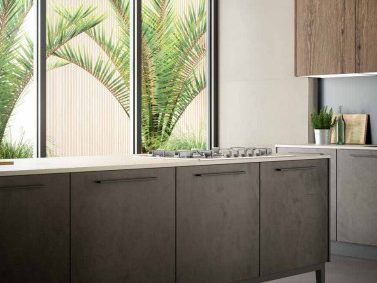“Green” enters the kitchen. We are not talking about the natural and organic foods that have been appearing on our plates for several years now, but precisely about cooking understood as structure. It happens more and more often that we find ourselves reading some more or less known acronyms among the materials for the production of furniture, including kitchens, a type of furniture that requires resistant materials that are almost indestructible.
The proper management of forests
FSC Certification (Forest Stewardship Council), for example, is an international certification that has been in existence since 1993, specifically for the forestry sector that recognizes products derived from forests that are properly and responsibly managed according to strict environmental, social and economic standards.
Ecology from oil
Then there is PET, an innovative material used by major brands in the industry to produce innovative and high-performance furniture surfaces. PET is one of the most eco-friendly and environmentally sustainable materials known at present. It is a synthetic material of the polyester family produced from petroleum, natural gas or other vegetable raw materials. It is also 100 percent recyclable, does not lose its basic properties during the recovery process, and can be transformed multiple times to make valuable products.
Today PET is used everywhere. Europe, North America and Asia are the regions that most exploit this valuable material, mainly for the production of beverage packaging.
Increasingly “green” furniture
In recent years, the world of furniture, as well as that of fashion, from niche brands to big names, such as Valentino, Gucci or Versace but not only, has evolved towards the use of “green” materials, protecting the environment and consumer health.
Alongside materials such as natural wood, marble and metal emphasize the innovation of 2023 kitchens. Then there are the fossil woods. Antique, worn and at the same time imbued with character, they give the room a warm and welcoming elegance. Cane-effect work on doors and paneling will also be a trend that will mark the months to come.
From films to textiles
PET, as mentioned, is a material that boasts two very important virtues today: eco-compatibility and eco-sustainability. Trasparenza cristallina, peso limitato, resistenza elevata e lunga durata sono le caratteristiche che fanno del PET una materia tanto apprezzata. Grazie alle sue proprietà, viene sempre più utilizzato in diversi ambiti. Crystalline transparency, limited weight, high resistance and long life are the characteristics that make PET a greatly appreciated material. Thanks to its properties, it is increasingly used in various fields. From container production to films to textiles. The possibilities offered by PET are endless. Years of research and development have transformed this synthetic material to make it one of the most innovative and future-oriented materials.
Why use Pet in the kitchen?
It will be good to understand what are the advantages of choosing a PET door in the kitchen. PET, as we have said, is a totally recyclable product that does not emit toxic substances into the environment and, therefore, respects the health of everyone in the home. What’s more, choosing a PET door means equipping your kitchen with a completely hygienic material that is also used in sanitary environments. PET doors also ensure great practicality due to their high resistance to scratching, staining and heat, as well as standing out for their up-to-date colors.
Stones and metals for richer finishes
New trends in the kitchen see a great use of metals: copper, brass, and steel, used both as accents and more extensively, on the doors of base, wall, and tall units. Metallic lacquers give brilliance, with warm or cool shades depending on the type of metal. This finish goes well with wood, marble or granite.
The charm of stone, which is also back in furniture fashion, is timeless. In the kitchen it becomes a protagonist, as in the case of stone islands, or a comprimary element, combined with other materials such as wood and metal. Whether it is used to customize bases or tops, but also wall units or column fronts, stone gives a sense of solidity and durability, as well as innate elegance.


























